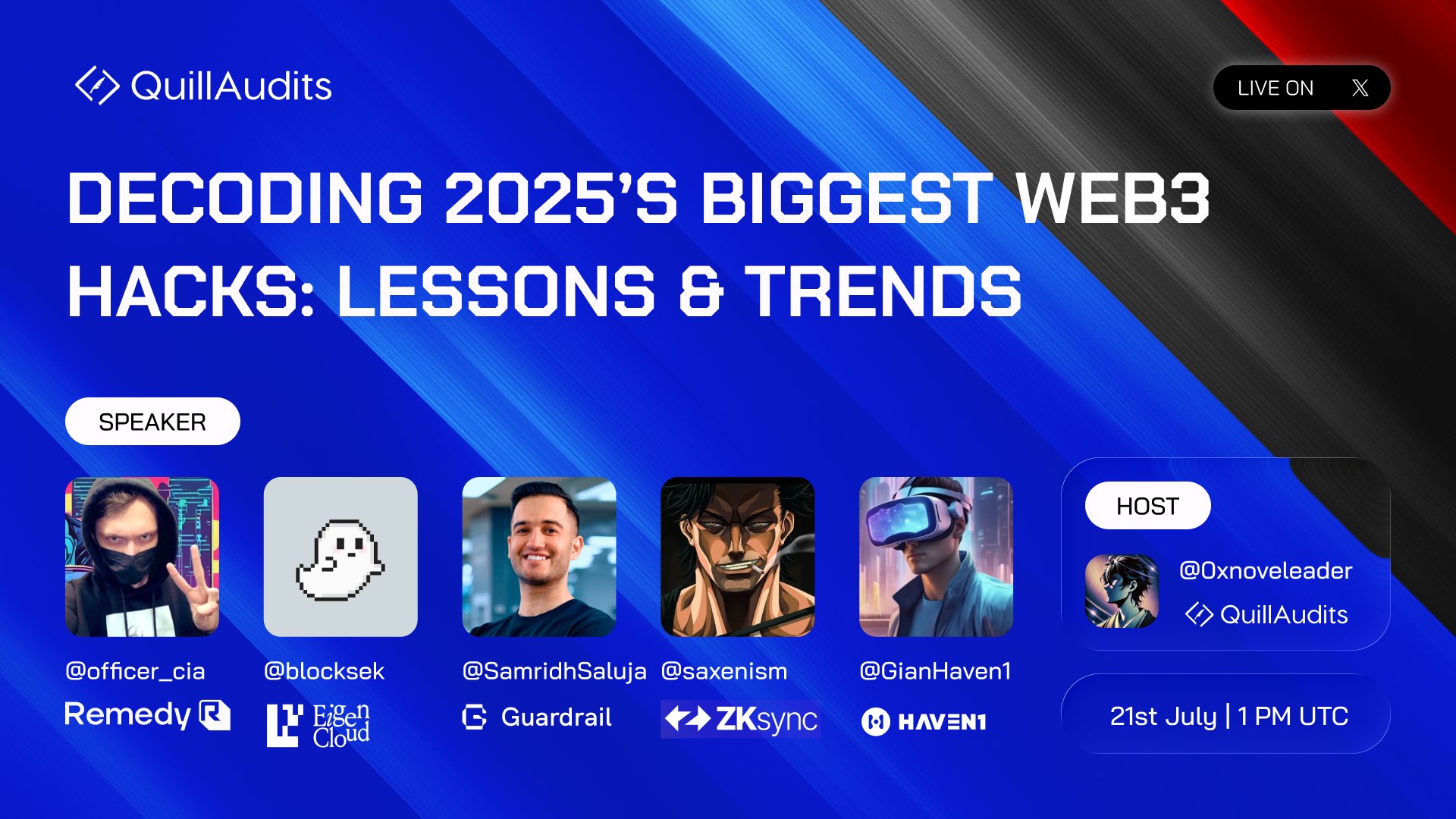TL;DR:
The discussion highlighted that while technical vulnerabilities remain important, the human element through social engineering and access control represents the dominant threat in 2025. Success requires a holistic approach combining technical controls, operational security, real-time monitoring, and most importantly, a security-first culture that scales with the value being protected.
"Everyone has a plan until you get punched in the face."
Samridh Saluja, Founder at Guardrail
Key stats discussed:
- H1 2025 losses already exceeded total 2024 losses ($2+ billion)
- Access control issues: 70% of funds lost ($1.6 billion)
- Social engineering: 15% of funds lost
- Three attack vectors combined: 95% of total losses
Listen to the X Spaces recording:
Main discussion points:
1. Social Engineering Attacks
The panel agreed that social engineering attacks are becoming increasingly sophisticated with AI tools, making them harder to detect. Key takeaways:
- Good OPSEC is essential but must be tailored to risk levels
- Isolated devices for crypto transactions recommended
- Pig butchering scams targeting new crypto users
- AI advancement making attacks more convincing
2. Access Control Issues
The dominant attack vector discussed, encompassing everything from private key compromises to infrastructure vulnerabilities:
- Not just smart contract issues - includes Web2 infrastructure
- Defense in depth approach needed
- Role-based access control crucial but complex to implement
- Regular monitoring and time locks recommended
- Proxy-in-the-middle attacks emerging as new threat
3. Protocol-Specific Security Measures
Each speaker shared unique approaches:
- EigenLayer's withdrawal queue system prevents immediate fund extraction
- ZKsync's enhanced monitoring and video verification for access requests
- Guardrail's real-time monitoring across 45+ chains
Key security recommendations:
- Implement defense in depth - Multiple layers of security
- Scale security investment with value - More value = more security
- Focus on permanent state changes - Protect irreversible actions
- Practice incident response - Quarterly drills minimum
- Use real-time monitoring - Detect attacks before completion
- Verify human requests - Video calls for sensitive access
- Isolate crypto operations - Dedicated devices and networks
- Stay updated on AI threats - Attackers using latest tools
Notable quotes:
- "Good OPSEC cannot be really defined for every entity by a single entity. It basically depends on the level of risk that you're operating at." - Raul
- "Everyone has a plan until you get punched in the face." - Samridh
- "When security is working well, you don't want to hear about it. You only hear about it when something's going wrong." - Samridh
- "The first focus that you should have...is on the place in your system where a permanent action is happening." - Raul
Speaker timestamps & key contributions:
Opening & Introduction
[00:00:00] @0xnoveleader (Quill Audits)
- Welcome and introduction of speakers
- Overview of H1 2025 hack statistics
- Introduction of three major attack vectors
Social Engineering Discussion
[00:03:00] @0xnoveleader (Quill Audits)
- Introduces social engineering topic
- Notes 15% of funds lost to these attacks
[00:04:00] @SamridhSaluja (Guardrail)
- AI making social engineering worse
- Importance of integrity monitoring
- Well-funded adversaries growing stronger
[00:08:00] @saxenism (ZKsync)
- Good OPSEC depends on risk level
- Comparison to testing strategies
- Need for layered security approach
[00:11:00] @blocksek (EigenCloud)
- EigenLayer's withdrawal queue mechanism
- Allows intervention even after compromise
- Prevents withdrawals to different wallets
Access Control Deep Dive
[00:13:00] @0xnoveleader (Quill Audits)
- 70% of funds lost to access control issues
- Links to social engineering and infrastructure
[00:14:00] @saxenism (ZKsync)
- Bybit hack discussion
- Web2 vs Web3 access control
- Implementation of comprehensive monitoring
[00:17:00] @SamridhSaluja (Guardrail)
- AI tools making attacks easier
- Private key compromise detection strategies
- Multisig monitoring importance
[00:20:00] @blocksek (EigenCloud)
- Proxy-in-the-middle attacks
- Smart contract deployment vulnerabilities
- Best practices for proxy initialization
[00:22:00] @officer_cia (Remedy)
- Importance of understanding access privileges
- Segregating roles effectively
- Impact awareness for access holders
Protocol-Specific Insights
[00:25:00] @blocksek (EigenCloud)
- Introduction to EigenCloud evolution
- Verifiable cloud infrastructure
- Suite of verification mechanisms
- Security considerations for different verification types
[00:35:00] Samridh Saluja (Guardrail)
- Guardrail platform overview
- Real-time monitoring across chains
- Common response failures from teams
- "It won't happen to us" fallacy
[00:45:00] @saxenism (ZKsync)
- Zero-knowledge proof security considerations
- Don't optimize ZK code
- Use battle-tested implementations
- Physical security for remote teams
- Video verification for access requests
Career Advice & Closing
[00:53:00] @blocksek (EigenCloud)
- Recommends Cipher Updraft for learning
- Participate in competitions
- Specialize in emerging tech like ZK
- Balance AI usage with fundamental knowledge
[00:56:00] @0xnoveleader (Quill Audits)
- Closing remarks
- Thanks to all speakers





